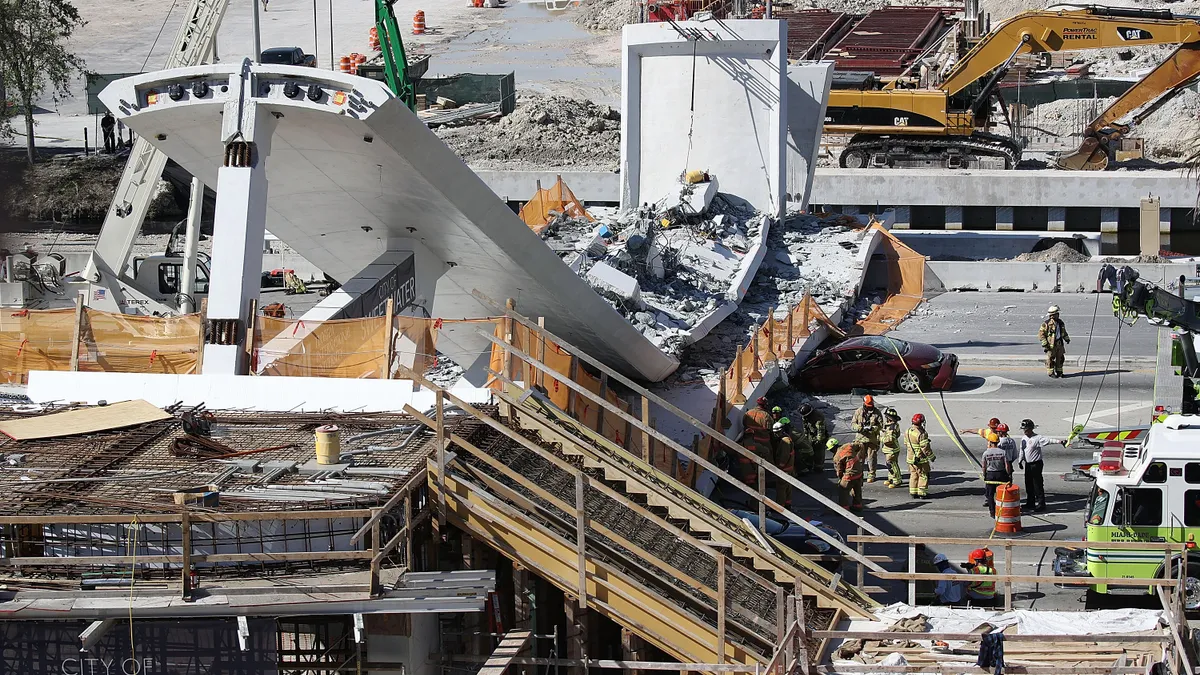Dive Brief:
- The last remaining lawsuit in the deadly 2018 bridge collapse at Florida International University has been scheduled for trial on Jan. 10, 2022, according to The Miami Herald. In March 2018, a pedestrian bridge fell atop a street, killing six people and injuring 10 others.
- The trial is for New Jersey-based Louis Berger Group, the independent consultant hired to verify the bridge's integrity and design by FIGG Bridge Engineers, the project engineer. Chelsea Brownfield, the widow of motorist Brandon Brownfield who was killed by the bridge collapse, is suing Berger for compensatory damages.
- Twenty-three companies sued by victims' families and survivors of the collapse have settled, including FIGG and general contractor Magnum Construction Management (MCM), formerly known as Munilla Construction Management, which later declared bankruptcy.
Dive Insight:
The National Transportation Safety Board’s (NTSB) investigation into the bridge collapse laid the majority of the blame on the span's design but also revealed major gaps in the project's construction and safety protocols by Florida-based FIGG Bridge Engineers' design.
The NTSB also named the lack of peer review by Louis Berger as a contributor to the collapse, along with failure on the part of many project players to recognize and act on the severity of the cracks.
In its October 2019 report, the NTSB determined that FIGG made errors in its calculations, which resulted in an underestimation of load and an overestimation of capacity. This was particularly apparent at the 11/12 nodal region, which was the area that exhibited significant cracking prior to the collapse. FIGG disputed the NTSB's conclusion that the collapse was a result of design errors.
Louis Berger, the board said, did not detect the inadequate design of the main span truss member 11/12 nodal region and connection to the bridge deck. Demand on the node was almost double FIGG’s calculations, and mistakes by the bridge design team resulted in an overestimation of the bridge’s capacity to resist shear in that region.
In a separate report from 2019, OSHA's Office of Engineering Services (OES) lambasted Berger. The Florida DOT requires that certain bridge structures be reviewed by an independent engineer at 30%, 60%, 90% and final completion. However, Berger told OES that FIGG had hired it only to conduct a final inspection. OES went so far as to say that if Berger had made inspections at the prescribed intervals, it is possible that the collapse could have been avoided.
Risks in reviews
Eric Ruzicka, a partner at Minneapolis-based law firm Dorsey & Whitney and one of the attorneys that represented a major engineering firm in lawsuits that resulted from the 2007 I-35W bridge collapse in Minneapolis, said there can be risks for firms that provide engineering reviews.
"I think those contracts are just fraught with danger because, inevitably, the entity isn't paying you to completely redesign the bridge," Ruzicka said. "There is some limited scope."
In general, Ruzicka says these contracts can limit the hours the engineering firm will inspect the project and the areas they will inspect. Engineer Ayman Shama, who conducted the review for Louis Berger, told investigators that investigating the critical node through his computer modeling analysis was beyond his scope of work.
"Doing this requires much more time and budget, which is going to exceed the budget and time agreed about with the designer," Shama said in an April 2018 interview with the NTSB. "In the beginning, I suggested to do this kind of analysis, to analyze the connections. I'm talking about the 21 nodes, or the joints to analyze the connections. However, the budget and time to do this actually was not agreed upon with the designer."
Ruzicka says expectations can be a common problem. There is often a disconnect between what the contract requires and what people not in the construction process expect if problems occur.
Even though the final trial among the contractors involved in the bridge collapse is now on the docket, there could still be more legal action to come. The Herald reports that Miami-Dade State’s Attorney’s Office and the Miami-Dade police homicide bureau are conducting a probe to determine if failure to close Southwest Eighth Street in Miami during the bridge work reaches the level of criminal negligence.
Ruzicka is surprised by the amount of time the investigation has taken to determine whether criminal charges are appropriate.
"The NTSB has reached its conclusion," Ruzicka said. "You've had a number of civil cases proceed to conclusion. There's nothing that the criminal process could not have figured out by now normally."














